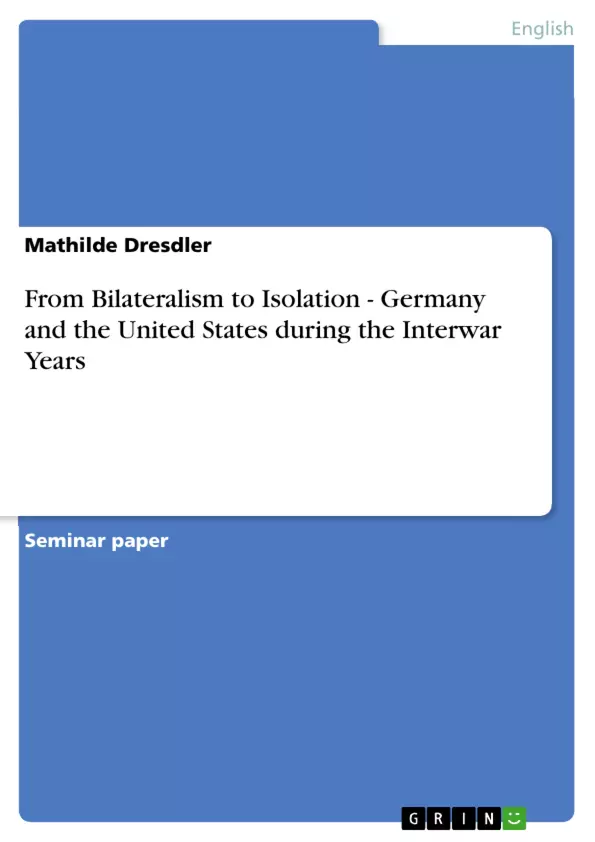After the peace of Paris in 1918, Germany and America gradually enhanced and improved their relationship. In 1921, the U.S. and Germany made a bilateral peace and diplomatic relations commenced. The trade agreement of 1923 could be considered as a confirmation of parallel interests and a well- working relationship. America provided Germany with loans to cure the German economy after the hyperinflation. Furthermore, the U.S. aimed to support the establishment of a healthy economy to help Germany enable to pay reparations and to have a market for its exports. Not all Germans, however, embraced the modernism pushed by America through their support. During the Weimar Years, the United States has assisted Germany in all crucial questions referring to reparations, reorganization and reintegration in Europe.
A multiplicity of issues has worsened the relationship in the 1930s. The United States and Germany could not agree in terms of disarmament, trade agreements and debts resulting from Dawes Plan loans and Austrian liabilities. Conferences to stabilize the situation and the peace in Europe failed. During his first years in office, the “Führer” had tried to compromise with America. However, he increasingly emancipated from the Allies and the Treaty of Versailles by making his own decisions regardless to the other nation’s opinion. The Neutrality Laws of 1935 constituted a relative freedom of decisions for Hitler. In spite of American neutrality, Roosevelt commented on Hitler’s decisions and aggressive foreign policy from 1937 onwards. This was also the turning point for the Nazis; articles in the BIZ, a newspaper being taken away from the Jewish owners and was now a Nazi institution, turned from neutral and positive comments on the New Deal to a hostile hate campaign (Junker, 1997: 246).
To bring matters to a head, ambivalence is obviously the best description of German- American relations in the interwar years. Fears, hopes, and interdependences shaped mutual perceptions during this period. From the first encounters after the First World War, to a special bilateral relationship in the 1920s, Germany and America had parted in the 1930s. Interestingly, both were developing toward isolation. The United States because of movements of isolationists, and Germany was isolating itself through its aggressive foreign policy. The America, however, got out of their isolation in 1937/1938. Germany only in 1945- defeated and destroyed.
Inhaltsverzeichnis (Table of Contents)
- Introduction
- World War I as a determinant of political relations
- Mutual perceptions during the Weimar-Years
- Changing relations- the United States and the Third Reich
- Political discrepancies as the source of continuous animosity.
- American isolationism...
- Roosevelt's push against unlimited neutrality.
- U.S. perceptions of Germany
- Hitler's perceptions of the United States
- Conclusion
Zielsetzung und Themenschwerpunkte (Objectives and Key Themes)
This text explores the evolving relationship between Germany and the United States in the aftermath of World War I, focusing on the period from the Weimar Republic to the rise of Nazi Germany. It examines how the two nations' perceptions of each other influenced their diplomatic, economic, and political relations. The text also delves into the complexities of American involvement in German affairs, particularly regarding the Treaty of Versailles and the economic reconstruction of Germany.
- The impact of World War I on US-German relations
- The evolution of mutual perceptions between Germany and the US
- The role of American economic and political influence in Germany
- The challenges of German-American cooperation in the face of differing political ideologies
- The impact of the rise of Nazism on US-German relations
Zusammenfassung der Kapitel (Chapter Summaries)
The introduction sets the scene by examining the initial stages of US-German relations following the First World War, highlighting the complex dynamic between the two nations as they navigated the aftermath of the conflict.
Chapter 1 dives into the legacy of World War I as a defining factor in the relationship between Germany and the United States. It explores how the war intensified existing tensions and fostered mutual distrust, shaping the perceptions and attitudes of each nation towards the other.
Chapter 2 explores the mutual perceptions held by Germany and the United States during the Weimar era. It examines the challenges of bridging the gap between the two countries' cultures, ideologies, and political systems. This chapter sheds light on the complexities of navigating the political landscape during a time of immense change and uncertainty.
Chapter 3 examines the shifting relationship between the United States and Germany under the Nazi regime. It analyzes the growing animosity between the two nations, highlighting the role of political discrepancies, American isolationism, and contrasting viewpoints on international affairs.
Schlüsselwörter (Keywords)
Key terms that encompass the central themes and topics explored in this text include World War I, Weimar Republic, Treaty of Versailles, American isolationism, Nazi Germany, mutual perceptions, political and economic relations, US-German relations, and international affairs.
- Quote paper
- Mathilde Dresdler (Author), 2010, From Bilateralism to Isolation - Germany and the United States during the Interwar Years, Munich, GRIN Verlag, https://www.grin.com/document/170978



